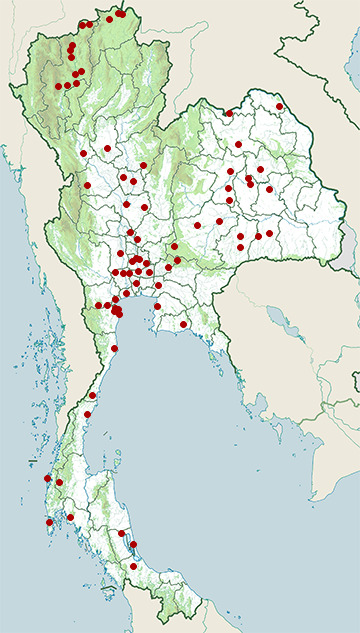Species of Thailand
Eastern marsh harrier
Circus spilonotus
Johann Jakob Kaup, 1847
In Thai: เหยี่ยวทุ่งพันธุ์เอเชียตะวันออก
The eastern marsh harrier (Circus spilonotus) is a bird of prey belonging to the marsh harrier group of harriers. It was previously considered to be conspecific with the western marsh harrier (Circus aeruginosus) but is now usually classified as a separate species. It has two subspecies: C. s. spilonotus in eastern Asia and C. s. spilothorax (Papuan harrier, perhaps a separate species) in New Guinea.
Description
It is 48 to 58 cm long with a wingspan of 113 to 137 cm; like most birds of prey, the female is usually larger than the male. The male's plumage is variable; typically the head, breast, back and wing-coverts are blackish with pale streaks. The rest of the wing is grey with black wingtips and a white front edge. The tail is grey, the rump is white and the underparts are mostly white. The female is dark brown with buff streaking on the head and underparts. The rump is often whitish and the tail has dark bars. Young birds are dark brown with buff on the head and a pale patch on the underwing.
It is usually silent but has a mewing call which is most often uttered at roost sites.
Distribution and habitat
Eastern marsh harriers are generally migratory apart from the Papuan harrier which is sedentary. The breeding range covers north-east China, Mongolia and south-east Siberia (as far west as Lake Baikal) with small numbers in northern Japan (Hokkaidō and northern Honshū). There is some overlap with western marsh harrier around Lake Baikal and interbreeding has taken place.
The wintering range includes southern China, Taiwan, Korea, southern Japan, north-east India, Bangladesh and South-east Asia as far south as the Philippines, Borneo and Sumatra. Large numbers of birds migrate along the Chinese coast with thousands passing through sites like Beidaihe during the autumn.
Its preferred habitat is open country including marshland, paddy fields and grassland.
Diet and reproduction
While hunting it flies low over the ground with the wings held in a shallow V-shape. Its prey includes small mammals, birds and frogs.
The breeding season begins in April. The nest is made of sticks and built on the ground, usually in a reedbed. Four to seven eggs are laid which are incubated for 33 to 48 days. The young birds fledge after 35 to 40 days.
This article uses material from Wikipedia released under the Creative Commons Attribution-Share-Alike Licence 3.0. Eventual photos shown in this page may or may not be from Wikipedia, please see the license details for photos in photo by-lines.
Category / Seasonal Status
Wiki listed status (concerning Thai population): Winter visitor
BCST Category: Recorded in an apparently wild state within the last 50 years
BCST Seasonal status: Non-breeding visitor
Scientific classification
- Kingdom
- Animalia
- Phylum
- Chordata
- Class
- Aves
- Order
- Accipitriformes
- Family
- Accipitridae
- Genus
- Circus
- Species
- Circus spilonotus
Common names
- Thai: เหยี่ยวทุ่งพันธุ์เอเชียตะวันออก
Conservation status

Least Concern (IUCN3.1)

Near Threatened (ONEP)
Photos
Please help us review the bird photos if wrong ones are used. We can be reached via our contact us page.
Range Map

- Ban Laem District, Phetchaburi
- Ban Phai District, Khon Kaen
- Bang Ban District, Phra Nakhon Si Ayutthaya
- Bang Len District, Nakhon Pathom
- Bang Phra Non-Hunting Area
- Bang Saphan Noi District, Prachuap Khiri Khan
- Bangkok Province
- Bueng Boraped Non-Hunting Area
- Bueng Khong Long Non-Hunting Area
- Chaloem Phrakiat Thai Prachan National Park
- Chiang Dao District, Chiang Mai
- Chiang Dao Wildlife Sanctuary
- Chiang Saen District, Chiang Rai
- Doi Inthanon National Park
- Doi Lo District, Chiang Mai
- Doi Pha Hom Pok National Park
- Doi Saket District, Chiang Mai
- Hat Yai District, Songkhla
- Huai Chorakhe Mak Reservoir Non-Hunting Area
- In Buri District, Sing Buri
- Kamphaeng Saen District, Nakhon Pathom
- Kantharawichai District, Maha Sarakham
- Khao Dinsor (Chumphon Raptor Center)
- Khao Sam Roi Yot National Park
- Khao Sok National Park
- Khao Yai National Park
- Khao Yoi District, Phetchaburi
- Khlong Lan National Park
- Klaeng District, Rayong
- Ko Phra Thong
- Kumphawapi District, Udon Thani
- Laem Pak Bia
- Mae Ai District, Chiang Mai
- Mae Chan District, Chiang Rai
- Mae Taeng District, Chiang Mai
- Mueang Chachoengsao District, Chachoengsao
- Mueang Chiang Mai District, Chiang Mai
- Mueang Kalasin District, Kalasin
- Mueang Khon Kaen District, Khon Kaen
- Mueang Krabi District, Krabi
- Mueang Lamphun District, Lamphun
- Mueang Maha Sarakham District, Maha Sarakham
- Mueang Nong Khai District, Nong Khai
- Mueang Phetchaburi District, Phetchaburi
- Mueang Samut Sakhon District, Samut Sakhon
- Mueang Samut Songkhram District, Samut Songkhram
- Mueang Sukhothai District, Sukhothai
- Mueang Suphanburi District, Suphan Buri
- Mueang Surin District, Surin
- Mueang Tak District, Tak
- Noen Maprang District, Phitsanulok
- Non Thai District, Nakhon Ratchasima
- Nong Bong Khai Non-Hunting Area
- Nong Song Hong District, Khon Kaen
- Pak Chong District, Nakhon Ratchasima
- Pak Phli District, Nakhon Nayok
- Pak Thale
- Phaisali District, Nakhon Sawan
- Phimai District, Nakhon Ratchasima
- Pho Prathap Chang District, Phichit
- Phra Nakhon Si Ayutthaya District, Phra Nakhon Si Ayutthaya
- Sai Noi District, Nonthaburi
- Sanam Bin Reservoir Non-Hunting Area
- Sathing Phra District, Songkhla
- Sena District, Phra Nakhon Si Ayutthaya
- Sikhoraphum District, Surin
- Taphan Hin District, Phichit
- Tha Wung District, Lopburi
- Thalang District, Phuket
- Thale Noi Non-Hunting Area
- Thanyaburi District, Pathum Thani
- Thawat Buri District, Roi Et
- Wang Noi District, Phra Nakhon Si Ayutthaya
- Wat Phai Lom & Wat Ampu Wararam Non-Hunting Area
